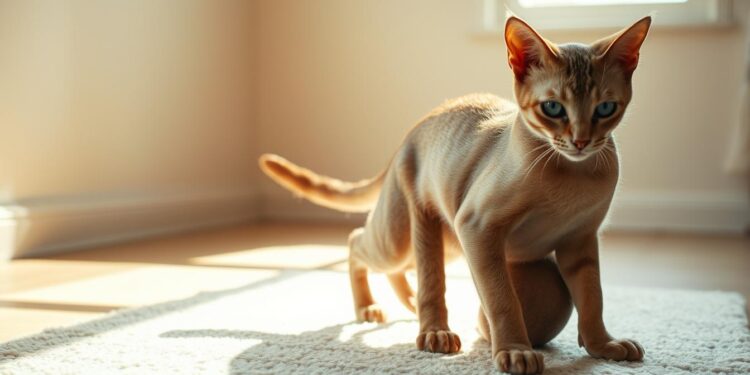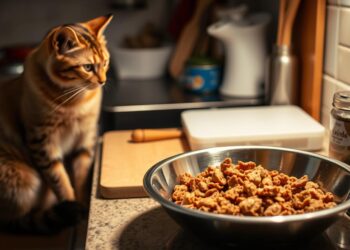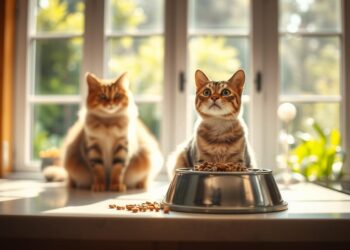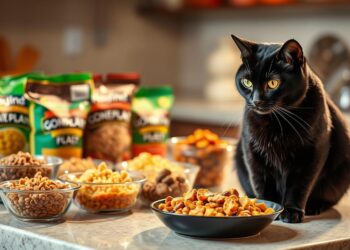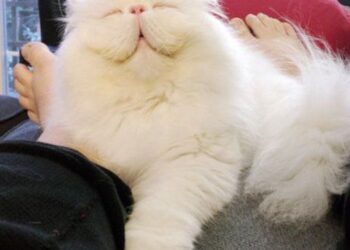As a responsible cat owner, it’s heartbreaking to see your pet struggle with weight issues. Imagine having to watch your once agile and playful companion turn into a lethargic and overweight feline. Unfortunately, this is a reality for many cat owners, with nearly 3 in 5 cats being overweight, according to the Association of Pet Obesity Prevention (APOP).
Maintaining a healthy weight is crucial for your cat’s overall well-being. Excess weight can lead to various health problems, including diabetes, arthritis, and heart disease. A well-planned feline weight loss strategy can help mitigate these risks and ensure your cat lives a longer, healthier life.
In this article, we will explore practical tips and strategies for achieving a healthy cat nutrition plan. By understanding the importance of a balanced diet and making informed decisions, you can help your cat achieve a healthy weight and improve their overall quality of life.
Understanding Your Cat’s Weight Issues
Obesity in cats is a serious condition that requires attention and proper management. As a cat owner, it’s essential to understand the factors that contribute to your cat’s weight issues.
Recognizing Signs of Overweight Cats
Identifying if your cat is overweight is the first step towards helping them lose weight. Some common signs include difficulty feeling their ribs, a rounded belly, and a lack of visible waistline. You can also check by gently feeling your cat’s body; if you can’t feel the ribs easily, it may be a sign of excess weight.
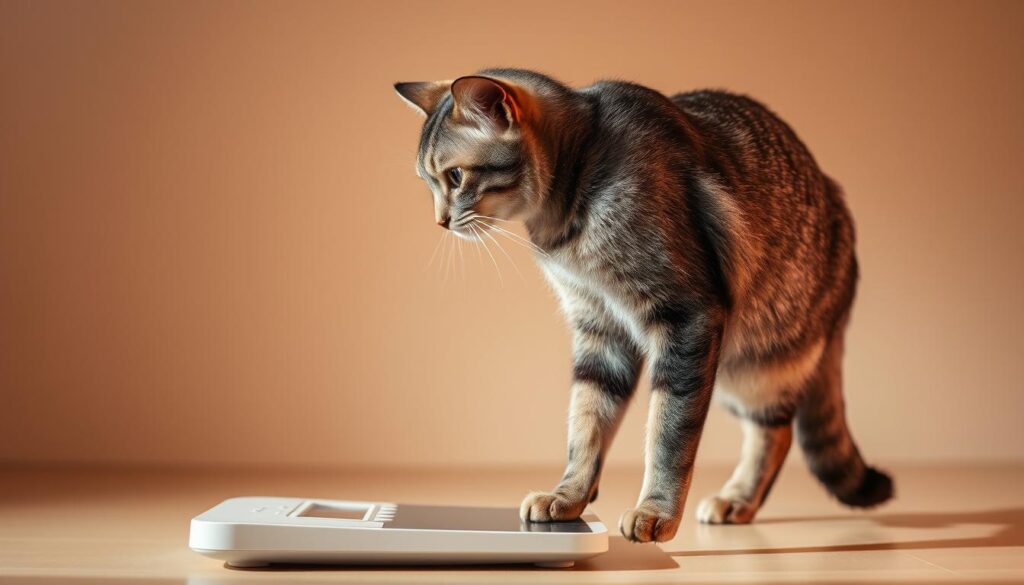
Health Risks Associated with Feline Obesity
Feline obesity is linked to various serious health conditions. Overweight cats are at a higher risk for developing diabetes, urinary disease, and arthritis. These conditions can significantly impact your cat’s quality of life and lifespan.
| Health Risk | Description |
|---|---|
| Diabetes | A metabolic disorder that affects insulin production, leading to high blood sugar levels. |
| Urinary Disease | Conditions such as kidney stones or urinary tract infections that can cause pain and discomfort. |
| Arthritis | Inflammation of the joints, leading to pain and reduced mobility. |
Setting Realistic Weight Loss Goals
Once you’ve identified that your cat is overweight, setting realistic weight loss goals is crucial. Aiming for a gradual weight loss of 1-2% body weight per week is a safe and achievable target. This can be achieved through a combination of diet tips for cats and increased physical activity.
- Consult with your veterinarian to determine an ideal weight for your cat.
- Develop a weight loss plan that includes healthy cat food choices.
- Monitor your cat’s progress regularly and adjust the plan as needed.
Essential Cat Dieting Strategies That Work
Effective cat dieting requires a multi-faceted approach that includes calorie control, gradual diet transitions, and regular exercise. By implementing these strategies, cat owners can help their pets achieve and maintain a healthy weight.
Calculating Your Cat’s Daily Calorie Needs
Understanding your cat’s daily calorie needs is crucial for developing an effective weight loss plan. The number of calories your cat requires depends on factors such as age, size, breed, and activity level. A general guideline is to reduce your cat’s daily calorie intake by 10-20% to promote weight loss. You can consult with your veterinarian to determine the ideal calorie intake for your cat.
For example, a typical adult cat requires around 200-250 calories per day. However, this can vary depending on the cat’s specific needs. Here is a sample table to illustrate the daily calorie needs for cats of different weights:
| Cat Weight (lbs) | Daily Calorie Needs |
|---|---|
| 8-10 | 200-220 |
| 11-13 | 240-260 |
| 14-16 | 280-300 |
Implementing Gradual Diet Transitions
Abrupt changes to your cat’s diet can lead to adverse reactions, such as digestive issues or loss of appetite. To avoid this, it’s essential to transition your cat to a new diet gradually. Start by mixing a small amount of the new food with their current food and gradually increase the proportion over 7-10 days.

Combining Diet with Appropriate Exercise
Regular exercise is vital for enhancing weight loss efforts in cats. Encourage your cat to engage in physical activity by providing toys, scratching posts, and climbing structures. You can also try interactive play or simply let your cat explore the outdoors under supervision.
A well-structured cat weight loss program should include a combination of diet and exercise. By working with your veterinarian and implementing these strategies, you can help your cat achieve a healthy weight and improve their overall well-being.
Selecting the Right Foods for Weight Management
Managing your cat’s weight starts with selecting the appropriate food that meets their nutritional needs. A well-balanced diet is crucial for maintaining overall health while helping your cat achieve or maintain a healthy weight.
Nutritional Requirements for Dieting Cats
Cats require a diet rich in protein and moderate in fat, with limited carbohydrates. When selecting a cat food for weight management, it’s essential to choose a formula that is high in protein and fiber, which helps in keeping your cat full and satisfied.
A nutrient-rich cat food should also contain essential vitamins and minerals. These nutrients support overall health and ensure that your cat is not malnourished during the weight loss process.
Wet vs. Dry Food for Weight Control
The debate between wet and dry food for cats has been ongoing. For weight control, wet food is often recommended because it typically has lower carbohydrate content and higher moisture levels, which can help reduce calorie intake.
On the other hand, dry food can be more convenient and helps maintain dental health. However, it’s crucial to choose a dry food that is low in carbs and made from high-quality ingredients.
- Wet food: Lower in carbs, higher in moisture.
- Dry food: Convenient, supports dental health.
Healthy Treats and Alternatives
Treats can be a significant obstacle to weight loss if not managed properly. Opt for low-calorie treats or consider using a portion of your cat’s regular meal as a treat.
Healthy alternatives to traditional treats include freeze-dried chicken or green beans. These options are not only lower in calories but also provide nutritional value.
- Choose low-calorie commercial treats.
- Use a portion of their meal as treats.
- Opt for healthy human foods like green beans.
Conclusion
A successful cat dieting plan involves more than just changing your cat’s food; it requires a comprehensive approach that includes diet, exercise, and regular veterinary check-ups. By understanding your cat’s weight issues and setting realistic weight loss goals, you can help your cat achieve a healthy weight.
Effective cat weight management involves calculating your cat’s daily calorie needs, implementing gradual diet transitions, and combining diet with appropriate exercise. Selecting the right foods for weight management is also crucial, including considering nutritional requirements, choosing between wet and dry food, and opting for healthy treats.
By taking a proactive and informed approach to your cat’s health, you can help prevent health risks associated with feline obesity. Regular monitoring and adjustments to their diet and exercise plan will support their overall health and longevity, ensuring a happy and healthy life for your cat.
